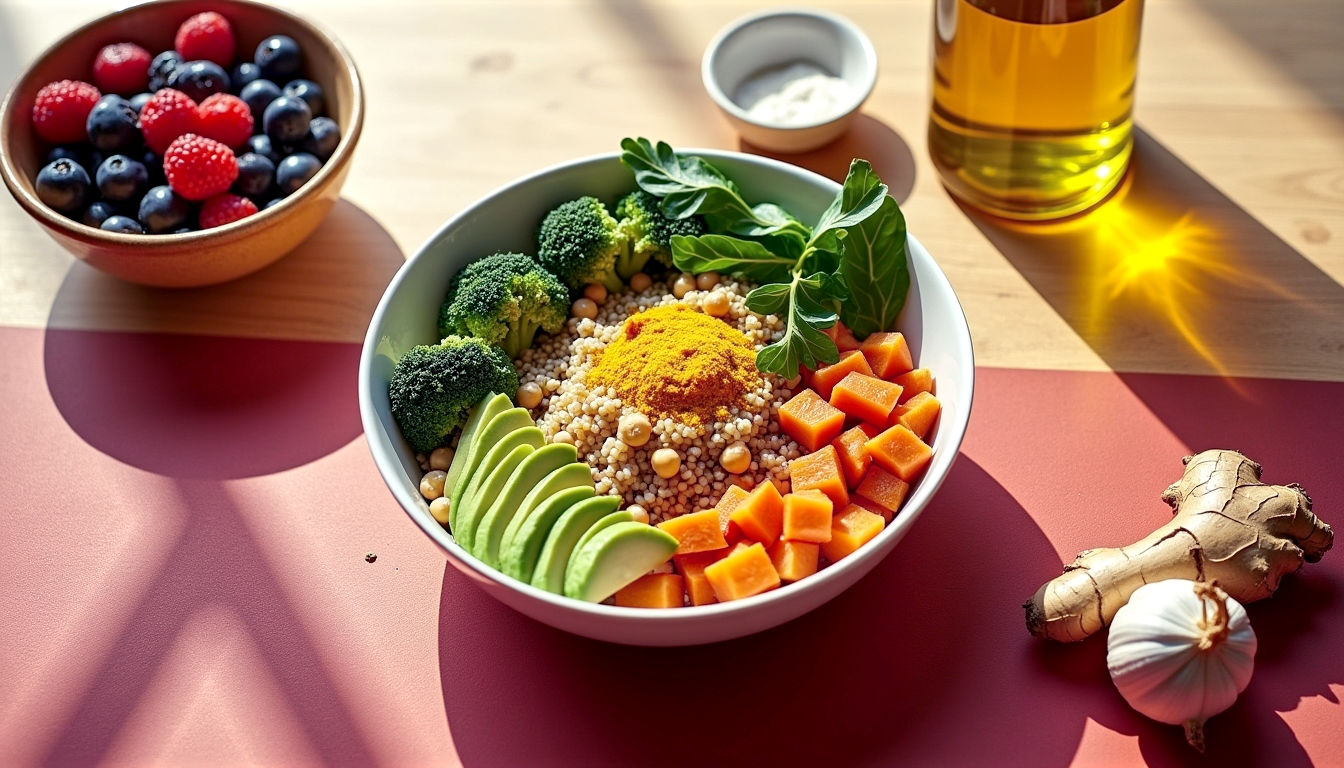Reducing Inflammation in the Body: A Practical Handbook for a Healthier You
Feeling tired and achy? This definitive guide explains chronic inflammation and gives you a practical, UK-focused plan to fight it with diet and lifestyle.

This post may contain affiliate links. If you make a purchase through these links, we may earn a commission at no additional cost to you.
Feeling a bit creaky, tired, or just not quite yourself? It might be down to something called inflammation. We’re not talking about the obvious swelling you get from a bee sting or a twisted ankle. We’re talking about a quiet, long-term inflammation that can bubble away inside your body for years, and it’s linked to just about every major health niggle you can think of—from achy joints and skin problems to more serious conditions like heart disease and diabetes.
But here’s the good news: you’re not powerless. Far from it. Your daily choices, from what you pop in your shopping trolley at Tesco to how well you sleep at night, have a massive impact. Think of this guide as your personal roadmap. We’ll break down what inflammation really is (no scary jargon, promise), explore the simple, science-backed ways you can cool it down, and give you practical tips that fit right into a busy British life. Ready to feel better? Let’s get started.
What on Earth Is Inflammation, Anyway?
Before we dive into fixing it, let’s get our heads around what inflammation actually is. Imagine you’ve just stubbed your toe on the leg of the sofa. Ouch. Within seconds, it gets red, swollen, and hot. That’s acute inflammation, and it’s your body’s brilliant, first-responder emergency service in action.
Your immune system rushes helpful white blood cells to the scene to fight off any germs and start the healing process. It’s a short, sharp, and incredibly useful reaction. Once the job is done, everything calms down, and your toe gets back to normal.
The trouble starts when this emergency service doesn’t switch off. This is called chronic inflammation. It’s a low-level, smouldering fire that can last for months or even years. Your body keeps sending out those inflammatory cells, but there’s no real injury to heal or germ to fight. Instead, these cells can start to damage healthy parts of your body, like your arteries, organs, and joints.
Think of it like this: acute inflammation is a controlled bonfire to clear away some dead leaves. Chronic inflammation is that same bonfire left to smoulder for weeks, slowly scorching the rest of the garden. It’s sneaky because you often don’t have obvious symptoms at first, just a vague feeling of being unwell, tired, or achy.
Why Is Everyone Talking About Chronic Inflammation Now?
It feels like you can’t open a magazine or browse a health website without hearing about inflammation. That’s because scientists are now realising just how central it is to our long-term health. For years, we thought conditions like heart disease were mainly about plumbing—clogged pipes (arteries) from too much cholesterol. Now, we know inflammation is a key villain in the story. It damages the artery walls, making it easier for those fatty plaques to build up.
It’s the same story for a whole host of modern health problems:
- Type 2 Diabetes: Inflammation can interfere with how your body uses insulin, the hormone that controls your blood sugar.
- Arthritis: In conditions like rheumatoid arthritis, the immune system mistakenly attacks the joints, causing painful inflammation.
- Gut Issues: Conditions like Crohn’s disease and ulcerative colitis are driven by chronic inflammation in the digestive tract.
- Skin Problems: Eczema, psoriasis, and even acne have inflammatory roots.
- Brain Health: Research is now linking chronic inflammation to conditions like depression and even an increased risk of dementia.
The modern world, with its processed foods, stressful lifestyles, and lack of sleep, has created the perfect storm for chronic inflammation to thrive. But the power to put out that fire is very much in your hands.
Your Anti-Inflammatory Toolkit: The Power of Food
Your diet is, without a doubt, the most powerful tool you have to control inflammation. What you eat can either fuel the fire or provide the cooling balm it needs. Let’s build your anti-inflammatory shopping list.
The Heroes: Foods That Fight Inflammation
Think of these foods as your body’s firefighters. You don’t need weird, expensive superfoods from the other side of the world. Many of the best are probably in your kitchen already. The goal is to eat a Mediterranean-style diet—lots of colourful plants, healthy fats, and lean protein.
1. Pile Your Plate with Fruits and Veggies
Plants are packed with antioxidants and polyphenols, which are natural compounds that calm inflammation. Aim for a rainbow of colours, as each colour provides different benefits.
- Berries: Strawberries, blueberries, raspberries, and blackberries are bursting with antioxidants called anthocyanins. A handful in your morning porridge or as a snack is a brilliant start.
- Leafy Greens: Spinach, kale, and rocket are rich in vitamin K and other anti-inflammatory goodies. Try wilting a big handful of spinach into your pasta sauce or curry.
- Cruciferous Veg: Think broccoli, cauliflower, and Brussels sprouts. They contain a powerful compound called sulforaphane that helps switch off inflammatory genes. Roasting them with a bit of olive oil makes them delicious.
- Tomatoes: Full of lycopene, a powerful antioxidant, especially when cooked. A simple tomato sauce is a health powerhouse.
2. Embrace Healthy Fats
Fat isn’t the enemy! The right kind of fat is essential for cooling inflammation. The superstars are omega-3 fatty acids.
- Oily Fish: This is your number one source. Aim for two portions a week of fish like salmon, mackerel, sardines, or herring. A classic British kipper for breakfast is a fantastic option.
- Nuts and Seeds: Walnuts, flaxseeds (also called linseeds), and chia seeds are excellent plant-based sources of omega-3s. Sprinkle them on salads, yoghurt, or porridge.
- Olive Oil: Extra virgin olive oil is the heart of the Mediterranean diet for a reason. It contains a compound called oleocanthal, which works a bit like ibuprofen. Use it for salad dressings and drizzling over cooked veg.
3. Spice Up Your Life
Many herbs and spices have been used for centuries for their healing properties, and modern science is now proving them right.
- Turmeric: This bright yellow spice contains curcumin, a hugely powerful anti-inflammatory compound. It’s what gives curry its colour. Add it to curries, soups, or even a ‘golden milk’ latte. A pinch of black pepper helps your body absorb the curcumin, so always use them together.
- Ginger: A brilliant natural remedy for nausea, ginger is also fantastic at reducing inflammation. Grate fresh ginger into stir-fries, curries, or make a soothing tea with hot water, ginger, and lemon.
- Garlic: This kitchen staple contains compounds that can inhibit the body’s pro-inflammatory messengers.
4. Don’t Forget Fibre
Fibre feeds the friendly bacteria in your gut. When these bacteria are happy, they produce short-chain fatty acids like butyrate, which is incredibly anti-inflammatory.
- Wholegrains: Swap white bread, pasta, and rice for their wholegrain versions—brown rice, wholewheat pasta, oats, and quinoa.
- Beans and Lentils: A tin of kidney beans in your chilli or some lentils in your soup is an easy and cheap way to boost your fibre intake.
- Green Tea: A lovely cuppa is not just comforting. Green tea is rich in polyphenols that have been shown to reduce inflammation and protect your cells.
The Villains: Foods That Fuel Inflammation
Just as important as what you add to your diet is what you limit. These are the main culprits that fan the flames of inflammation.
- Sugar and Refined Carbs: This is enemy number one. Sugary drinks, sweets, biscuits, cakes, and white bread cause your blood sugar to spike. This triggers the release of inflammatory messengers called cytokines. Think of sugar as pouring petrol on the fire.
- Processed and Fried Foods: Crisps, takeaways, and ready meals are often cooked in processed vegetable oils (like sunflower or corn oil) that are high in omega-6 fatty acids. We need some omega-6, but our modern diet gives us far too much in relation to omega-3, which throws our body’s inflammation balance out of whack.
- Processed Meats: Sausages, bacon, and deli meats are often high in saturated fats and advanced glycation end products (AGEs), which are highly inflammatory. Try to keep these as an occasional treat rather than an everyday staple.
- Excessive Alcohol: While a single glass of red wine might have some benefits, drinking too much puts a strain on your liver and promotes inflammation throughout your body.
Making changes doesn’t have to be about deprivation. It’s about smart swaps. Swap that fizzy drink for sparkling water with a slice of lemon. Swap the sugary breakfast cereal for a bowl of porridge with berries. Small changes, done consistently, add up to a huge difference.
Beyond the Plate: Lifestyle Tweaks for a Calmer Body
You can eat the perfect diet, but if other parts of your life are out of balance, that smouldering fire of inflammation will keep burning. Here’s where else to focus your efforts.
1. Move Your Body (But Don’t Overdo It)
Exercise is a bit of a Goldilocks situation. Too little is bad, but too much can also be a problem.
Moderate, regular movement is the sweet spot. When you exercise, your muscles release anti-inflammatory chemicals that circulate around your body. It helps you maintain a healthy weight, which is crucial because excess body fat, particularly around the belly, is like a factory for producing inflammatory substances.
What kind of exercise is best? The kind you enjoy and will stick with!
- A brisk 30-minute walk most days is brilliant. It’s free, easy, and you can do it anywhere.
- Cycling, swimming, or dancing are all fantastic options.
- Strength training (using weights, resistance bands, or your own body weight) is also important for building muscle, which helps regulate your metabolism and blood sugar.
- Yoga and Tai Chi are wonderful because they combine gentle movement with stress-reducing mindfulness.
The key is consistency. Find something you love and build it into your weekly routine, just like a doctor’s appointment you can’t miss.
2. Prioritise a Good Night’s Sleep
Sleep is when your body does its essential repair and housekeeping. Skimping on it is one of the fastest ways to fire up inflammation. When you’re sleep-deprived, your body pumps out more inflammatory molecules. Over time, this can wreak havoc.
Most adults need 7 to 9 hours of quality sleep a night. If you’re struggling, focus on your ‘sleep hygiene’:
- Stick to a routine: Go to bed and wake up at roughly the same time every day, even at weekends. This helps set your internal body clock.
- Create a restful environment: Make sure your bedroom is dark, quiet, and cool.
- Switch off screens: The blue light from phones, tablets, and TVs an hour before bed can trick your brain into thinking it’s still daytime, messing with the sleep hormone melatonin. Read a book instead.
- Avoid caffeine and alcohol late at night: Both can disrupt the quality of your sleep.
3. Manage Your Stress Levels
Just like your body has a physical stress response (inflammation), it has a mental one too. And the two are deeply linked. When you’re chronically stressed—worried about work, money, or family—your body is flooded with the stress hormone cortisol.
In the short term, cortisol is actually anti-inflammatory. But when the stress never lets up, your body can become resistant to cortisol’s effects, allowing inflammation to run wild. It’s like the boy who cried wolf; your body stops listening.
Finding healthy ways to manage stress is non-negotiable for cooling inflammation.
- Mindfulness and Meditation: Even just 10 minutes a day can make a difference. Apps like Calm or Headspace are great for beginners. It trains your brain not to get so caught up in worried thoughts.
- Spend time in nature: A walk in a park, the woods, or by the sea—what doctors are now calling ‘green prescribing’—is a powerful and proven stress-buster.
- Connect with others: Having a good chat with a friend or family member is one of the best ways to put your worries into perspective.
- Breathe: When you feel stressed, take a few slow, deep belly breaths. It instantly activates your body’s ‘rest and digest’ system, calming the stress response.
4. Look After Your Gut
Your gut is home to trillions of microbes—bacteria, fungi, and viruses—collectively known as your microbiome. This bustling community plays a huge role in regulating your immune system and inflammation. If the balance of good to bad bacteria gets thrown off (a state called dysbiosis), it can lead to a ‘leaky gut’, where the gut lining becomes more permeable. This allows toxins and undigested food particles to leak into your bloodstream, triggering a massive inflammatory response.
How can you keep your gut microbes happy?
- Eat a diverse range of plants: Aim for 30 different types of plant foods a week (including fruits, veggies, nuts, seeds, grains, and legumes). Each plant feeds a different type of good bacteria.
- Include fermented foods: Things like live yoghurt, kefir (a fermented milk drink), sauerkraut, and kimchi are full of beneficial probiotic bacteria.
- Limit processed foods and artificial sweeteners: These can disrupt the delicate balance of your gut microbiome.
Supplements: A Helping Hand, Not a Magic Bullet
The first and most important place to get your anti-inflammatory compounds is from real, whole foods. However, in some cases, certain supplements might offer an extra boost. It’s always best to chat with your GP or a registered nutritional therapist before starting any new supplement, especially if you have existing health conditions or are on medication.
- Omega-3 (Fish Oil): If you don’t eat oily fish regularly, a good quality fish oil supplement can be very helpful. Look for one that provides a decent dose of EPA and DHA, the two most active forms of omega-3.
- Curcumin (from Turmeric): To get a therapeutic dose, you’d have to eat a huge amount of turmeric. A supplement can provide a more concentrated dose. Look for one that includes piperine (from black pepper) to aid absorption.
- Vitamin D: The ‘sunshine vitamin’ is crucial for a healthy immune system. In the UK, it’s impossible to get enough from the sun during the autumn and winter months. The NHS recommends everyone consider taking a daily 10-microgram supplement during this time.
Putting It All Together: A Day in an Anti-Inflammatory Life
This all sounds great in theory, but what does it actually look like in practice? Here’s a simple example of a day designed to cool inflammation.
- Morning: Start your day with a big glass of water. For breakfast, have a bowl of porridge made with whole oats, topped with a handful of blueberries, a sprinkle of flaxseeds, and a few walnuts. Swap your usual milky coffee for a cup of green tea.
- Lunchtime: Instead of a beige sandwich, have a colourful salad with a big base of rocket and spinach. Add some protein like grilled chicken or a tin of chickpeas, some chopped tomato and cucumber, and a dressing made with extra virgin olive oil, lemon juice, and a pinch of salt. At your lunch break, get outside for a brisk 20-minute walk.
- Afternoon: If you feel a slump, snack on an apple and a small handful of almonds instead of reaching for the biscuit tin.
- Evening: For dinner, have a fillet of baked salmon with a side of roasted broccoli and sweet potato wedges. Fancy a curry? Make your own with plenty of turmeric, ginger, and garlic, and pack it with lentils and vegetables.
- Before Bed: Wind down by reading a book instead of scrolling on your phone. If you feel stressed, do a 10-minute guided meditation. Aim to be in bed at a reasonable time to get at least 7 hours of sleep.
Chronic inflammation might be a major force behind modern disease, but it’s not a life sentence. By making thoughtful, consistent choices about what you eat, how you move, and how you live, you can turn down the heat, calm the fire within, and build a foundation for vibrant, long-lasting health. It’s not about perfection; it’s about progress. Start with one small change today, and your body will thank you for it tomorrow.
Further Reading & Reputable Resources
For those who wish to delve deeper, these organisations provide trustworthy, evidence-based health information:
- The NHS (National Health Service): The UK’s primary source for health advice, including detailed information on diet, lifestyle, and managing conditions. www.nhs.uk
- The British Dietetic Association (BDA): The professional body for UK dietitians, offering reliable, science-backed food and nutrition fact sheets. www.bda.uk.com
- The British Heart Foundation (BHF): Provides excellent resources on heart-healthy eating, which strongly aligns with an anti-inflammatory diet. www.bhf.org.uk
- Versus Arthritis: A leading UK charity for people with arthritis, offering specific advice on how diet and lifestyle can help manage inflammatory joint conditions. www.versusarthritis.org






